|
|
|
Thank you for
attending
Mayfest & visiting the Tree booth this year. The free trees
are provided through a collaboration of several local groups.
Our partners are:
 City
of Fort Worth Parks & Community Services Department,
Forestry Section
maintain all trees on public
property within Fort Worth.
They
also offer free tree planting programs, volunteer
programs and opportunities to get involved in the
community, and conduct the heritage tree program. City
of Fort Worth Parks & Community Services Department,
Forestry Section
maintain all trees on public
property within Fort Worth.
They
also offer free tree planting programs, volunteer
programs and opportunities to get involved in the
community, and conduct the heritage tree program.
Forestry provides the organizational & logistical
support for the Mayfest Tree booth, as well as recruits
volunteers to operate it. |
Tell us
your Mayfest tree story! We want to hear how your tree is
doing.
e-mail us!
After
planting, be sure to register your tree with
Tree North Texas.
Tree North Texas is the regional
urban forestry initiative involving 40 communities in North
Texas. This program will be the largest tree planting initiative
in the nation, with a plan to plant 3 million trees in North
Texas during the next 10 years.
Click here to see our progress.
Click here to register your tree.
Tree Planting & Care Instructions
 |
PLANTING
-
Dig a hole twice as wide as the root ball and as
deep
-
Roughen
the sides
and bottom of the hole
-
Add
soil to bottom to bring root ball level to
surrounding soil line or slightly higher
-
Orient
the tree
-
Check
for circling roots, loosen them, score the
root ball
-
Backfill
with same native soil, tamp down & water
|
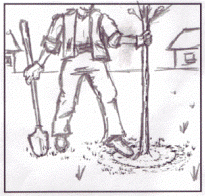 |
MULCH
-
Build
mulch ring around root ball
-
Add
mulch about 1 -2 inches deep
-
Keep
mulch away from the trunk of tree (mulch
around the trunk can cause bark suffocation
or rot)
-
Avoid
injury to trunk with weed-eaters or lawn
mowers the mulch ring will help protect
the tree
|
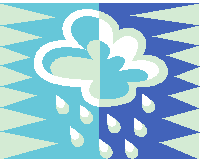 |
WATERING
-
Water
seedling once a week through summer, until
established
-
Water
slowly & deeply so that water soaks deep
into the soil (not like you would water
grass)
|
|
|
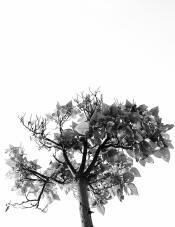 |
STAKING
-
You
should not have to stake the tree because it
is so small(it will establish a stronger
root system when not staked)
-
In
the future, if you feel
staking is necessary, stake loosely so that
tree can sway (this encourages lateral root
growth)
-
Remove
staking within one year
|
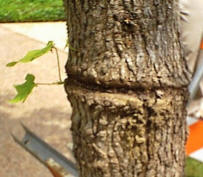
Staking damage. The staking system girdled the
tree trunk because it was not removed as the tree grew.
This causes permanent damage & it compromises the health
& safety of the tree. |
-
Prune
any dead or damaged limbs at time of
planting
-
Do
not do any aesthetic pruning until the end
of the second growing season
-
Remove
co-dominant leaders (so that there is only
one main dominant branch)
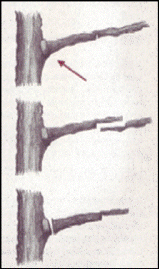
|
Join Cross Timbers
Urban Forestry Council & "grow" with us!
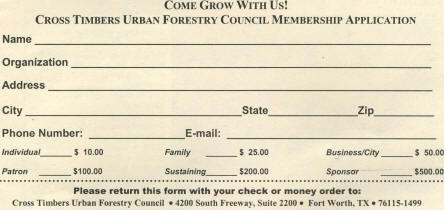
Mayfest Tree Species for 2013
|
Bald Cypress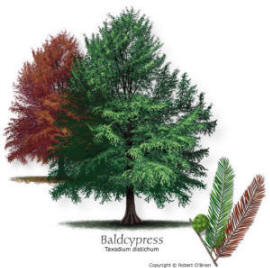 (Taxodium distichum)
(Taxodium distichum)
Growth Rate:
Rapid
Height:
50 +,
Spread:
25-50
Soils:
Sand,
loam, clay, limestone
Shade Tolerance:
Full
sun, part shade
Water Requirements:
Drought
resistant
Wildlife Value:
structure & branching provides habitat for wildlife
Native:
Central & East
Texas native
Comments:
Brilliant burnt orange fall color; naturally occurring
in moist areas, but does well in dry areas, ancient
tree: known to the dinosaurs, knees arise if soil has
poor drainage
Graphic
from Robert O'Brien; Texas Forest Service - Texas Tree
Planting Guide |
|
Bur Oak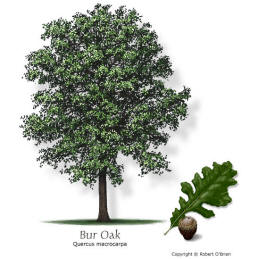 (Quercus
macrocarpa)
(Quercus
macrocarpa)
Growth Rate:
Slow
Height:
50
+, Spread: 50 +
Soils:
Sand,
loam, clay, caliche
Shade
Tolerance:
Full
sun, part sun, part shade
Water
Requirements:
Drought resistant
Wildlife Value:
acorns, important food source for birds & mammals, good
canopy substrate for insectivorous birds, larval host
for Sleepy & Juveniles Duskywing butterflies
Native:
North
Texas native
Comments:
Provides deep shade, has few insect or disease problems,
graceful, attractive leaves, long-lived
Graphic from Robert
O'Brien; Texas Forest Service - Texas Tree Planting
Guide
|
|
Green Ash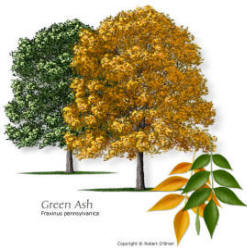 (Fraxinus
pennsylvanica)
(Fraxinus
pennsylvanica)
Growth Rate:
Rapid
Height:
40-50, Spread: 30 - 40
Soils:
Sand,
loam, clay, limestone
Shade
Tolerance:
Full
sun, part sun
Water
Requirements:
Drought resistant
Wildlife Value:
Seeds
& buds eaten by many birds, good nesting & cover tree
for birds, some mammals browse leaves, larval host for
Eastern Tiger Swallowtail & Orange Sulfur butterflies
Native:
North
Texas native
Comments:
Hardy, fast growing tree with deep green summer color
and yellow fall foliage; able to grow in most soils
Graphic from Robert
O'Brien; Texas Forest Service - Texas Tree Planting
Guide
|
Live Oak (Quercus
virginiana)
(Quercus
virginiana)
Growth Rate:
Moderate
Height:
50 +,
Spread:
50 +
Soils:
sand,
loam, clay, limestone
Shade Tolerance:
Full
sun, part shade
Water Requirements:
Drought
resistant
Wildlife Value:
acorns are eaten by variety of wildlife, good cover &
nesting tree, good substrate for insectivorous birds,
larval host for Horaces Duskywing & Northern White
Hairstreak butterflies
Native:
North
Texas native
Comments:
Beautiful, spreading canopy with mostly
evergreen leaves; symbol of the South, susceptible to
Oak Wilt
Graphic
from Robert O'Brien; Texas Forest Service - Texas Tree
Planting Guide
|
Shumard Red Oak
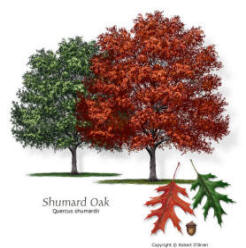 (Quercus shumardii)
(Quercus shumardii)
Growth Rate:
Rapid
Height:
50 +,
Spread:
25 - 50
Soils:
Sand,
loam, clay, limestone, caliche
Shade Tolerance:
Full
sun, part shade
Water Requirements:
Drought
resistant
Wildlife Value:
Excellent nesting & cover, good substrate for
insectivorous birds, acorns are relished by many
mammals, gamebirds & songbirds, larval host for Horaces
Duskywing & Northern White Hairstreak
Native:
North
Texas native
Comments:
Beautiful fall color, upright shape; provides good
shade, susceptible to Oak Wilt
Graphic from Robert O'Brien; Texas Forest Service -
Texas Tree Planting Guide |
|
|
|